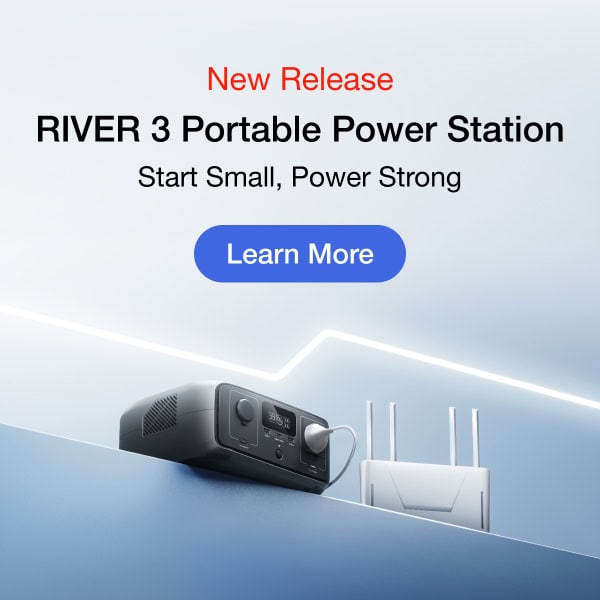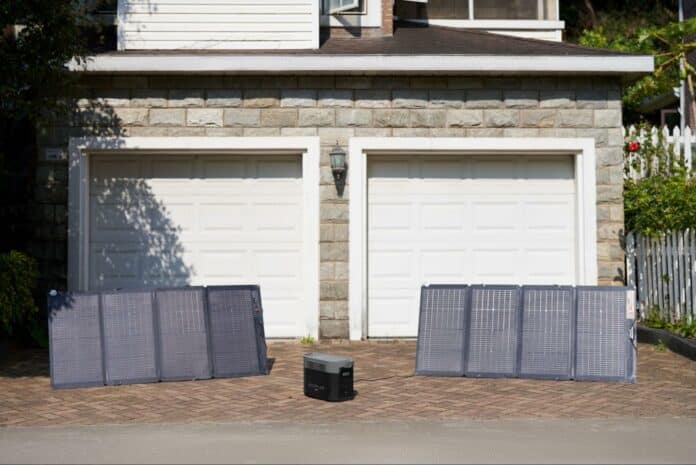Purchasing solar panels in 2023 is cheaper than it’s ever been. Improved technology and a widespread decrease in price mean it’s the perfect time to go solar.
A standard photovoltaic (PV) panel will cost you between £150 and £750 depending on the manufacturer, quality, and rated power output (wattage).
A complete residential solar system averages between £5,000 and £11,000.
Numerous factors determine how much you’ll spend (and save) by switching to solar.
Let’s take a closer look.
Cost of Solar Panel System per kWh
As you probably already know from your electricity bill, the unit of consumption utility companies use to charge you is typically kilowatt-hours (kWh).
Quite simply, a watt-hour (wH) or kWh measures how much electricity you use over time.
Wh or kWh = # of watts consumed in 1 hour
Every home is different, but the average monthly electricity consumption of British households is 242 kWh — or 8kWh per day.
Off-grid solar power solutions measure capacity in several different ways.
- Storage (Battery) Capacity — Like your electricity bill, this is measured in wH and kWh. It indicates the maximum amount of electricity a portable power station or other balance of system can store and supply without recharging.
- Power Output (AC) Capacity — This crucial metric indicates the maximum amount of electricity a portable power station can supply at any given time. If you try to power an appliance — or numerous appliances simultaneously — that exceeds the maximum AC Output, it won’t work. Additionally, many household appliances require more power to turn on than to operate. Typically this is called “Surge Power” or ‘Starting Wattage”, and should be indicated on the manufacturer’s label. Thanks to proprietary x-boost tech, EcoFlow’s off-grid power solutions can deliver an additional burst of power to get heavyweight appliances up and running.
- Solar Input/Charge Capacity
With off-grid solar systems, you can’t just add unlimited PV panels. Solar input capacity measures the maximum amount of solar energy a portable power station can convert to household electricity. Depending on the model, EcoFlow’s portable power stations can support anywhere from one 100W rigid solar panel to eight 400W rigid solar panels (3,200W maximum) with 2 x DELTA Pros chained together using a dual voltage hub.
You’ll need to consider all of these factors — and your household’s electricity consumption requirements — before purchasing a solar panel system that meets your needs.
Here’s an at-a-glance table to give you a rough idea of how much an off-grid solar panel system might cost based on storage capacity and number of solar panels — and how much you can save on electricity bills.
| Electricity Storage Capacity | Average Cost | Number of Solar Panels | Roof Space | Annual Electricity Savings |
| 3kWh System | £5,000-£6,000 | 12 | 22 m² | £850 |
| 4kWh System | £6,000-£8,000 | 16 | 29 m² | £980 |
| 5kWh System | £8,000-£9,000 | 20 | 32 m² | £1,460 |
| 6kWh System | £9,000-£11,000 | 24 | 43 m² | £1,460+ |

Solar Panel Installation Costs
Installation costs can make up a substantial part of your initial investment in a solar panel array. They can vary enormously depending on roof size, the type of system installed — and who you hire.
If you’re trying to keep costs down, purchasing the solar panels and balance of system and installing it yourself may be possible.
However, most people go for an integrated package with installation included. While suppliers don’t typically advertise how much they charge for installation, it usually works out to £300 to £500 per person per day. Smaller systems should be up and running in a single day with two people working, while a sizeable 6kWh system with 24 PV panels can take two or three days to install completely.
On average, you’re probably looking at between £1,500 and £3000 for a complete solar system installation.

Factors Affecting How Much Solar Panels Cost
Numerous factors can affect the cost of solar panels, ranging from the number and type of solar panels to who installs them.
Number of Solar Panels
All things being equal, the more solar panels you require to meet your electricity consumption needs, the higher the overall cost.
That said, more high-wattage solar panels equals more electricity generation, reducing your reliance on mains electricity (or eliminating it altogether). The more money you save on electricity bills, the higher your potential return on investment over the long term.
Type of Solar Panels
There are three types of residential photovoltaic panels: monocrystalline, polycrystalline, and thin film. Each has advantages and disadvantages, and the materials used can significantly affect pricing.
While several factors differentiate them, conversion efficiency is what most people look for when purchasing solar panels. Solar panel efficiency indicates the percentage of sunlight PV panels can convert to electricity. As you might expect, prices are generally higher for monocrystalline solar panels, which boast the highest efficiency.
Thin film panels are the newest and least common of the three types. These thin photovoltaic panels are low-cost. However, that also means lower rated power and efficiency than polycrystalline or monocrystalline panels.
Thin film flexible solar panels are best for augmenting a higher wattage rigid or portable solar panel array. Their extreme flexibility and lightweight construction can help you maximise available surface area and facilitate installation on irregular or curved exteriors.
Polycrystalline is typically a step up in efficiency from thin film at an average rating of 14%-16%. Polycrystalline PV panels are also relatively low cost, usually between £0.90 and £1 per watt — but you’ll need more panels to generate the same amount of electricity as more efficient options.
With an efficiency rating of up to 23%, monocrystalline panels lead the way in efficiency and longevity, making them the first choice for most homeowners purchasing solar panels. The average cost is only slightly higher at around £1 to £1.50 per watt — and you’ll save more money on electricity over the long term.
Type of Installation
There are two fundamental choices for installation: DIY or expert.
Hiring a reputable installer is best if you’ve never worked with wiring and electricity or are uncomfortable climbing on your roof. It may cost you up to several thousand pounds, but you’re paying for expertise and peace of mind. Skilled professionals will have handled challenging and hazardous installations before.
Also, you can void your warranty if you inadvertently damage the panels during a DIY installation — potentially a costly mistake.
One substantial benefit of working with a reputable contractor is their experience and expertise in maximising your roof space by correctly positioning and angling the solar panels so that they receive the most sunlight. Even the most efficient solar panels will perform better when they receive more sun.
But don’t let us scare you off. If you want to do it yourself and save some money, take it slow and seek advice from online communities or someone who’s done it before.
Carefully consider the number of panels required, roof structure, optimal placement and orientation, mounting hardware and tools needed, etc.
Plug-and-play systems like EcoFlow’s solar generators take most of the hard work out of DIY installations. With an all-in-one portable power station like the DELTA Pro and 400W rigid solar panels, you can eliminate any potential compatibility issues across your system — and no wiring is required.
Anyone with basic DIY experience can install EcoFlow’s rigid solar panels with mounting hardware and connect them using standard solar cables.
Labour Costs
Some local solar companies may include installation in the overall price if you purchase your system from them. If not, you’ll be looking at between £1,500 and £3000 for a complete solar system installation calculated on a per person per day basis.
Another way companies may charge for installation is per watt. Labour for such schemes often works out at around 20 pence per watt. This usually results in a lower overall cost than daily or hourly labour, but it’s always worth doing your sums beforehand.
Assuming the 20p standard, a 3kW system would cost £600 to install, a 6kW £1,200, and an 8kW system would be £1,600.
Additional Components (Balance of System)
In addition to solar panels, numerous components are required for both off-grid and grid-tied solar power systems. Without many of them, your solar power system won’t function. It makes sense to install them simultaneously to keep overall costs down.
Balance of system (BOS) components include:
- Solar inverter
- Solar battery bank
- Charge controller
- Battery management system (BMS)
- Mounting system, wiring, and switches
A solar battery isn’t necessary for grid-tied power systems but is required for off-grid systems. You can only generate solar energy during daylight hours — a solar battery allows you to store electricity for later use. While technically, it is possible to have an off-grid system without a battery, you would be severely limited in your electricity consumption.
Adding a solar battery to a grid-tied system gives you additional energy security during a power outage.
The price of solar batteries varies depending on the size of the system and battery type, but you can expect to pay in the region of £1,200 to £6,000.
Or you can purchase an all-in-one solution like an EcoFlow portable power station and not worry about buying all the balance of system components (including the solar battery) separately.
A solar inverter is another vital BOS component for off-grid and grid-tied systems. It converts the direct current (DC) electricity soaked up by solar panels into household (AC) electricity. AC electricity is what the power grid and the vast majority of home appliances use.

How Much Can I Expect To Save With Solar Panels in the UK?
Switching to solar power can save you significant money on your electricity bills over the long term. It can even eliminate them entirely! Your return on investment will be impacted by whether you’re using a grid-tied or off-grid system.
Using clean, renewable solar power wisely could save you between £670 and £1,400+ per year using a grid-tied system. Your savings will increase over the lifespan of the panels. If you sign up for the Smart Electricity Guarantee, your savings over 25 years could be £21,250 to £40,325+, depending on your system and tariff.
If you’re using an off-grid system, the sky’s the limit. Those diligent with their electricity consumption can never worry about utility bills again.
Considering the average three-bedroom UK household currently pays around £1,156.31 per year, it’s a substantial saving.

How Much Will I Get Paid for the Electricity I Generate With Solar Panels?
If you’re using an off-grid solar power system, you won’t get paid for the electricity you generate as you won’t feed it back into the grid. However, as we’ve seen above, an off-grid system will save you substantially on utility bills, reduce your dependence on ageing infrastructure and insulate you from rising fuel costs.
If you use a grid-tied system and sign up for the Smart Export Guarantee, your supplier will pay you for any excess energy sent back to the National Grid. It’s not a huge amount, but every little helps. Considering it doesn’t require you to do anything beyond installing the system, it’s a win-win. Tariffs vary from supplier to supplier, with 2p per kWh generally the lowest, going up to 15p.
On average, a 3kW system installed will earn around £75 per year through the SEG. A 4kW system earns roughly £100, and a 5kW system in the region of £120 per year. The more electricity you generate above your consumption, the higher your earnings.

How Long Will It Take To Break Even on the Cost of Solar Panels?
In the UK, the average break-even period for a solar panel system (often called the solar payback period) is 10.4 years. However, that can go down to as little as 6 or 7 years, depending on the system, government incentives, energy consumption, and on-grid electricity prices after switching to solar.

Is Government Funding or Tax Incentives Available for Solar Panels in the UK?
Government funding and tax incentives might be available to you in the UK. The EC04 Scheme is open to low-income, fuel-poor, and vulnerable households receiving benefits and could cover the entire or partial cost of solar panel installation up to £14,000.
This is currently the only government grant option available in the UK, though the Smart Export Guarantee offers a healthy incentive to switch to solar if you’re staying grid-tied.
Another significant benefit that makes switching to solar even more attractive right now is the zero VAT rate on “energy-saving products” that’s been in place since 1st April 2022 and is set to continue until March 2027.
Frequently Asked Questions
What Is the Average Cost of Solar Panels in the UK?
The average cost for solar panels in the UK is between £150, for a 100W panel with a low efficiency, to around £600 for a 400W rigid solar panel with an efficiency of around 23%.
Are Solar Panels Worth It in the UK?
Using solar panels in the UK is undoubtedly worth it — especially over the long term. Lower overall prices and better technology mean there’s never been a more enticing time to go solar. Switching to clean, renewable solar power could save you thousands every year. Off-grid systems offer true energy independence, while a grid-tied system could make you eligible for the SEG.
Final Thoughts
Significant technological strides and more affordable prices mean the solar industry is soaring right now. Reducing your carbon footprint, your dependence on the grid — and the bills that come with it — means there’s never been a better time to embrace clean, renewable solar power.
With EcoFlow, switching to solar doesn’t have to be daunting. With plug-and-play portable power stations and modular Power Kits ranging from 3.6kWh to 25 kWh of capacity, there’s an off-grid solar power solution that’s right for you.
Our monocrystalline solar panels offer industry-leading efficiency and are compatible with grid-tied and off-grid power systems.
EcoFlow allows you to customise the solar power system that meets your family’s unique electricity needs.
Solar is the future — what are you waiting for?





